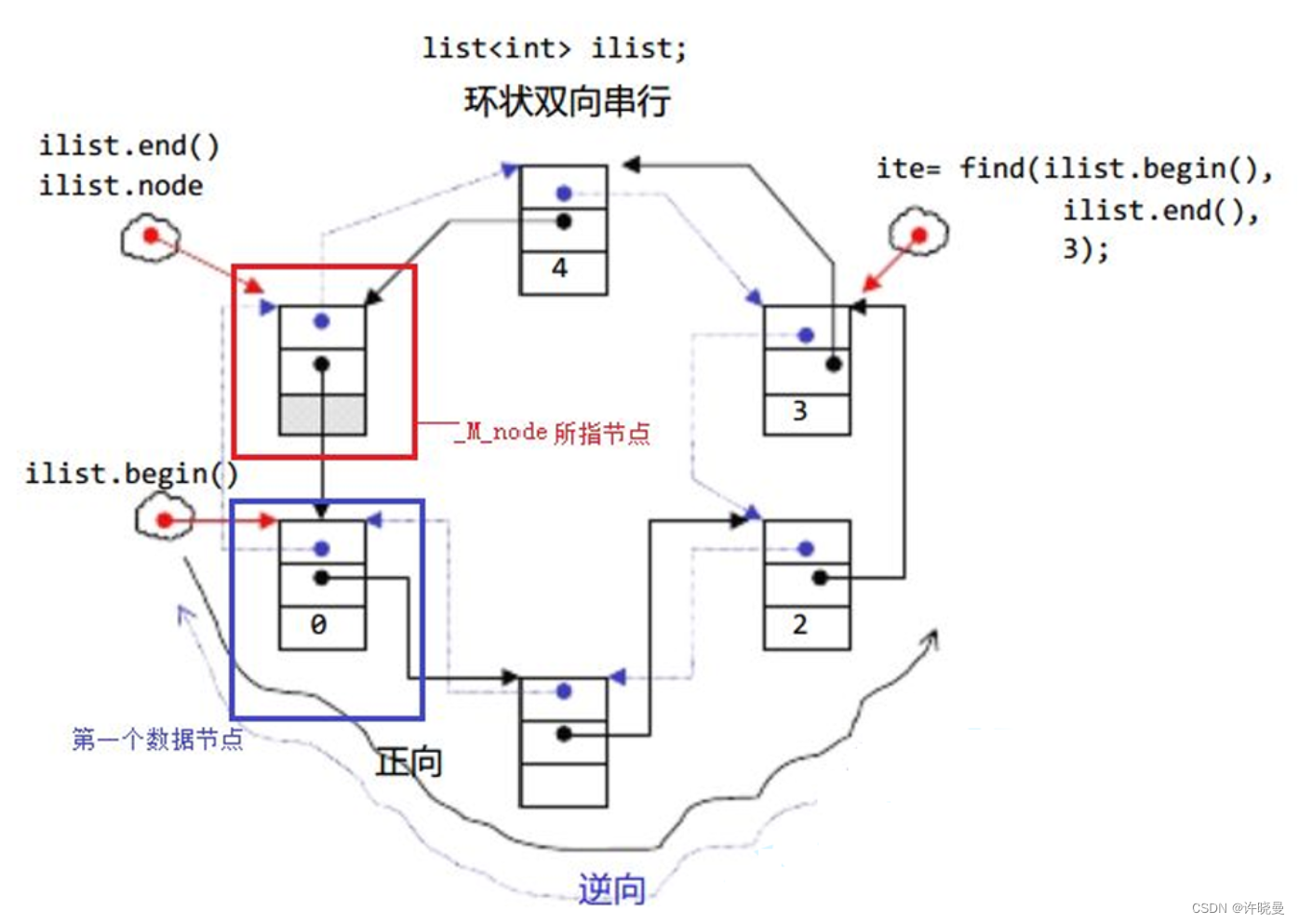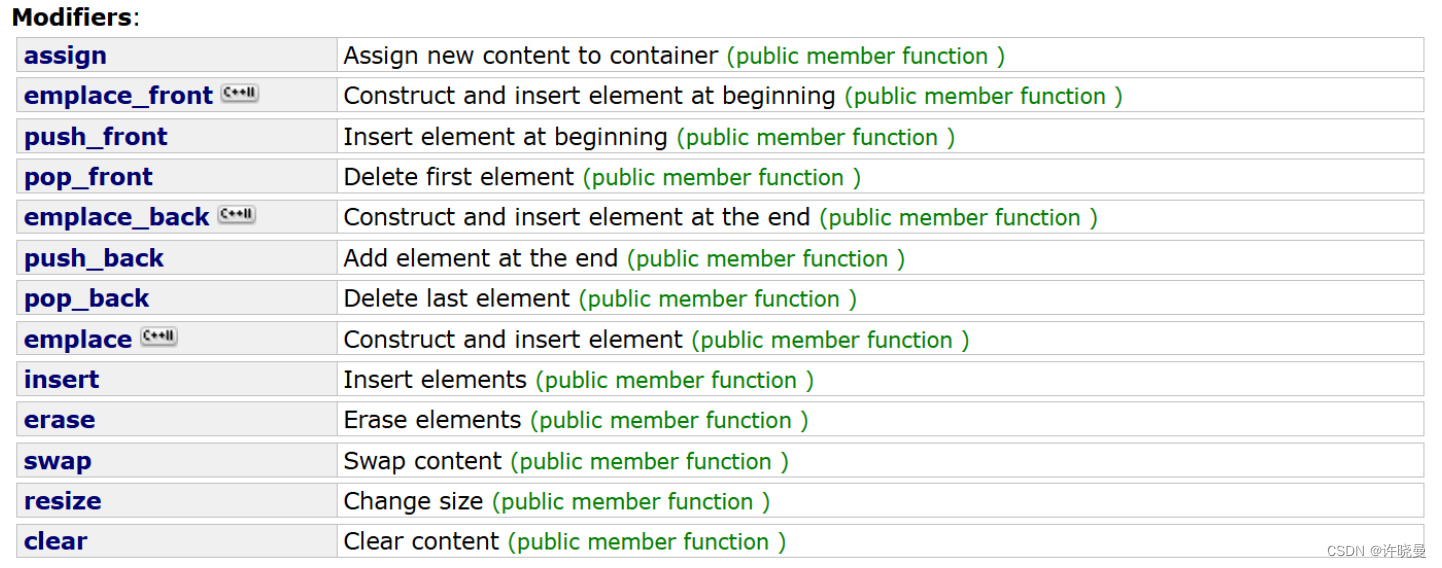文章目录
- 标准库中的list
- list的迭代器失效
- list的反向迭代器
- [list 与 vector的对比](#list 与 vector的对比)
标准库中的list
list是可以在常数范围内在任意位置进行插入和删除的序列式容器 ,并且该容器可以前后双向迭代。list的底层是双向链表结构,双向链表中每个元素存储在互不相关的独立节点中,在节点中通过指针指向其前一个元素和后一个元素。list与forward_list非常相似:最主要的不同在于forward_list是单链表,只能朝前迭代,已让其更简单高效。- 与其他的序列式容器相比(
array,vector,deque),list通常在任意位置进行插入、移除元素的执行效率更好。 - 与其他序列式容器相比,
list和forward_list最大的缺陷是不支持任意位置的随机访问 ,比如:要访问list的第6个元素,必须从已知的位置(比如头部或者尾部)迭代到该位置,在这段位置上迭代需要线性的时间开销;list还需要一些额外的空间 ,以保存每个节点的相关联信息(对于存储类型较小元素的list来说这可能是一个重要的因素)

list的构造

Example:
C++
#include <iostream>
using namespace std;
#include <list>
#include <vector>
// list的构造
void TestList1()
{
list<int> l1; // 构造空的l1
list<int> l2(4, 100); // l2中放4个值为100的元素
list<int> l3(l2.begin(), l2.end()); // 用l2的[begin(), end())左闭右开的区间构造l3
list<int> l4(l3); // 用l3拷贝构造l4
// 以数组为迭代器区间构造l5
int array[] = { 16,2,77,29 };
list<int> l5(array, array + sizeof(array) / sizeof(int));
// 列表格式初始化C++11
list<int> l6{ 1,2,3,4,5 };
// 用迭代器方式打印l5中的元素
list<int>::iterator it = l5.begin();
while (it != l5.end())
{
cout << *it << " ";
++it;
}
cout << endl;
// C++11范围for的方式遍历
for (auto& e : l5)
cout << e << " ";
cout << endl;
}list的迭代器
list的迭代器类型是一个自定义类型,包含了指向结点的指针,重载了*,->,++,``--,==,!=`等运算符。
在使用时可以简单理解为指向结点的指针。
Example:
C++
#include <iostream>
using namespace std;
#include <list>
#include <vector>
// list迭代器的使用
// 注意:遍历链表只能用迭代器和范围for
void PrintList(const list<int>& l)
{
// 注意这里调用的是list的 begin() const,返回list的const_iterator对象
for (list<int>::const_iterator it = l.begin(); it != l.end(); ++it)
{
cout << *it << " ";
// *it = 10; 编译不通过
}
cout << endl;
}
void TestList2()
{
int array[] = { 1, 2, 3, 4, 5, 6, 7, 8, 9, 0 };
list<int> l(array, array + sizeof(array) / sizeof(array[0]));
// 使用正向迭代器正向list中的元素
// list<int>::iterator it = l.begin(); // C++98中语法
auto it = l.begin(); // C++11之后推荐写法
while (it != l.end())
{
cout << *it << " ";
++it;
}
cout << endl;
// 使用反向迭代器逆向打印list中的元素
// list<int>::reverse_iterator rit = l.rbegin();
auto rit = l.rbegin();
while (rit != l.rend())
{
cout << *rit << " ";
++rit;
}
cout << endl;
}list的容量

可以看到,相比于string和vector,list不支持reserve、shink_to_fit等接口,因为链表的底层并不是一块连续的空间,每次插入都需要开辟新的空间,所以不必提前开空间,删除同理。不过list支持了resize、clear等接口,使用较少。
list的访问

前文已提到,list不支持随机访问,又因为list是双向循环链表,所以可以获取头部元素和尾部元素。
list的修改

相比于string和vector,list提供了头插和头删,这也是由于list的底层空间是不连续的有关,元素之间通过指针建立联系,删除头部元素不会导致后续元素的移动,所以list提供了头插和头删,同时还有insert。这些接口在string、vector中要么没有提供,要么不提倡使用,因为效率实在低下。
Example:
C++
#include <iostream>
using namespace std;
#include <list>
#include <vector>
// list插入和删除
// push_back/pop_back/push_front/pop_front
void TestList3()
{
int array[] = { 1, 2, 3 };
list<int> L(array, array + sizeof(array) / sizeof(array[0]));
// 在list的尾部插入4,头部插入0
L.push_back(4);
L.push_front(0);
PrintList(L);
// 删除list尾部节点和头部节点
L.pop_back();
L.pop_front();
PrintList(L);
}
// insert /erase
void TestList4()
{
int array1[] = { 1, 2, 3 };
list<int> L(array1, array1 + sizeof(array1) / sizeof(array1[0]));
// 获取链表中第二个节点
auto pos = ++L.begin();
cout << *pos << endl;
// 在pos前插入值为4的元素
L.insert(pos, 4);
PrintList(L);
// 在pos前插入5个值为5的元素
L.insert(pos, 5, 5);
PrintList(L);
// 在pos前插入[v.begin(), v.end)区间中的元素
vector<int> v{ 7, 8, 9 };
L.insert(pos, v.begin(), v.end());
PrintList(L);
// 删除pos位置上的元素
L.erase(pos);
PrintList(L);
// 删除list中[begin, end)区间中的元素,即删除list中的所有元素
L.erase(L.begin(), L.end());
PrintList(L);
}
// resize/swap/clear
void TestList5()
{
// 用数组来构造list
int array1[] = { 1, 2, 3 };
list<int> l1(array1, array1 + sizeof(array1) / sizeof(array1[0]));
PrintList(l1);
// 交换l1和l2中的元素
list<int> l2;
l1.swap(l2);
PrintList(l1);
PrintList(l2);
// 将l2中的元素清空
l2.clear();
cout << l2.size() << endl;
}list的迭代器失效
前面说过,大家可将迭代器暂时理解成指针,迭代器失效即迭代器所指向的节点的无效,即该节点被删除了。因为list的底层结构为带头结点的双向循环链表,因此在list中进行插入时是不会导致list的迭代器失效的,只有在删除时才会失效,并且失效的只是指向被删除节点的迭代器,其他迭代器不会受到影响。
C++
// 错误示例
void TestListIterator1()
{
int array[] = { 1, 2, 3, 4, 5, 6, 7, 8, 9, 0 };
list<int> l(array, array+sizeof(array)/sizeof(array[0]));
auto it = l.begin();
while (it != l.end())
{
// erase()函数执行后,it所指向的节点已被删除,因此it无效,在下一次使用it时,必须先给其赋值
l.erase(it);
++it;
}
}
// 正确示例
void TestListIterator()
{
int array[] = { 1, 2, 3, 4, 5, 6, 7, 8, 9, 0 };
list<int> l(array, array+sizeof(array)/sizeof(array[0]));
auto it = l.begin();
while (it != l.end())
{
l.erase(it++); // 或 it = l.erase(it);
}
}list的反向迭代器
通过前面例子知道,反向迭代器的++就是正向迭代器的--,反向迭代器的--就是正向迭代器的++,因此反向迭 代器的实现可以借助正向迭代器,即:反向迭代器内部可以包含一个正向迭代器,对正向迭代器的接口进行 包装即可。
C++
template<class Iterator>
class ReverseListIterator
{
// 注意:此处typename的作用是明确告诉编译器,Ref是Iterator类中的类型,而不是静态成员变量
// 否则编译器编译时就不知道Ref是Iterator中的类型还是静态成员变量
// 因为静态成员变量也是按照 类名::静态成员变量名 的方式访问的
public:
typedef typename Iterator::Ref Ref;
typedef typename Iterator::Ptr Ptr;
typedef ReverseListIterator<Iterator> Self;
public:
//
// 构造
ReverseListIterator(Iterator it): _it(it){}
//
// 具有指针类似行为
Ref operator*(){
Iterator temp(_it);--temp;
return *temp;
}
Ptr operator->(){return &(operator*());}
//
// 迭代器支持移动
Self& operator++(){
--_it;
return *this;
}
Self operator++(int){
Self temp(*this);--_it;
return temp;
}
Self& operator--(){
++_it;
return *this;
}
Self operator--(int)
{
Self temp(*this);
++_it;
return temp;
}
//
// 迭代器支持比较
bool operator!=(const Self& l)const{return _it != l._it;}
bool operator==(const Self& l)const{return _it == l._it;}
Iterator _it;
}list 与 vector的对比
| vector | list | |
|---|---|---|
| 底层结构 | 动态顺序表,一段连续空间 | 带头结点的双向循环链表 |
| 随机访问 | 支持随机访问,访问某个元素效率O(1) | 不支持随机访问,访问某个元素效率O(n) |
| 插入和删除 | 任意位置插入和删除效率低,需要搬移元素,时间复杂度为O(n),插入时有可能需要增容,增容:开辟新空间,拷贝元素,释放就空间,导致效率更低 | 任意位置插入和删除效率高,不需要搬移元素,时间复杂度为O(1) |
| 空间利用率 | 底层为连续空间,不容易造成内存碎片,空间利用率高,缓存利用率高 | 底层结点动态开辟,小姐点容易造成内存碎片,空间利用率低,缓存利用率低 |
| 迭代器 | 原生指针 | 对原生指针(节点指针)进行封装 |
| 迭代器失效 | 在插入元素时,要给所有的迭代器重新赋值,因为插入元素有可能会导致重新扩容,致使原来迭代器失效,删除时,当前迭代器需要重新赋值,否则会失效 | 插入元素不会导致迭代器失效,删除元素时,只会导致当前迭代器失效,其他迭代器不受影响 |
| 使用场景 | 需要高效存储,支持随机访问,不关心插入删除效率 | 大量插入和删除操作,不关心随机访问 |